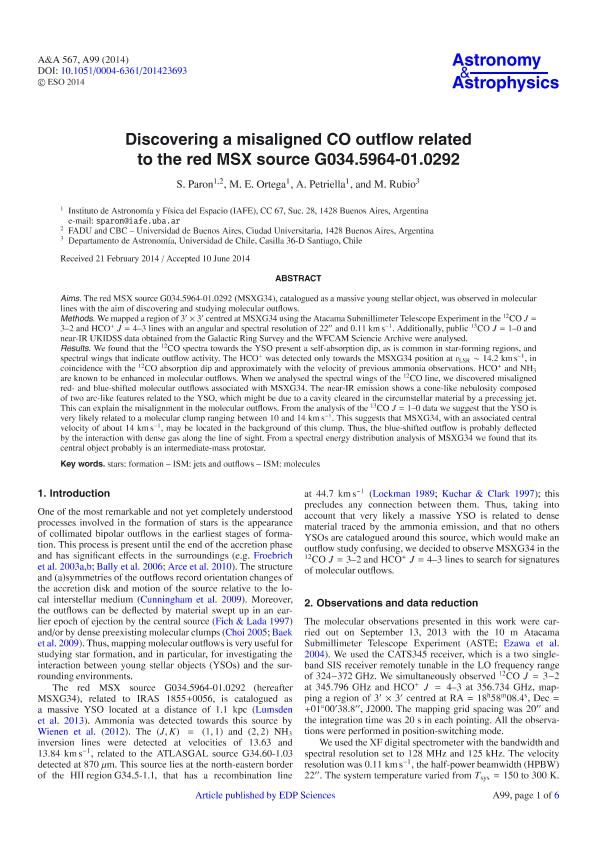Artículo
Discovering a misaligned CO outflow related to the red MSX source G034.5964-01.0292
Fecha de publicación:
06/2014
Editorial:
Edp Sciences
Revista:
Astronomy And Astrophysics
ISSN:
0004-6361
Idioma:
Inglés
Tipo de recurso:
Artículo publicado
Clasificación temática:
Resumen
Aims. The red MSX source G034.5964-01.0292 (MSXG34), catalogued as a massive young stellar object, was observed in molecular lines with the aim of discovering and studying molecular outflows.
Methods. We mapped a region of 3′× 3′ centred at MSXG34 using the Atacama Submillimeter Telescope Experiment in the 12CO J = 3–2 and HCO+J = 4–3 lines with an angular and spectral resolution of 22′′ and 0.11 km s-1. Additionally, public 13CO J = 1–0 and near-IR UKIDSS data obtained from the Galactic Ring Survey and the WFCAM Sciencie Archive were analysed.
Results. We found that the 12CO spectra towards the YSO present a self-absorption dip, as is common in star-forming regions, and spectral wings that indicate outflow activity. The HCO+ was detected only towards the MSXG34 position at vLSR ~ 14.2 km s-1, in coincidence with the 12CO absorption dip and approximately with the velocity of previous ammonia observations. HCO+ and NH3 are known to be enhanced in molecular outflows. When we analysed the spectral wings of the 12CO line, we discovered misaligned red- and blue-shifted molecular outflows associated with MSXG34. The near-IR emission shows a cone-like nebulosity composed of two arc-like features related to the YSO, which might be due to a cavity cleared in the circumstellar material by a precessing jet. This can explain the misalignment in the molecular outflows. From the analysis of the 13CO J = 1–0 data we suggest that the YSO is very likely related to a molecular clump ranging between 10 and 14 km s-1. This suggests that MSXG34, with an associated central velocity of about 14 km s-1, may be located in the background of this clump. Thus, the blue-shifted outflow is probably deflected by the interaction with dense gas along the line of sight. From a spectral energy distribution analysis of MSXG34 we found that its central object probably is an intermediate-mass protostar.
Palabras clave:
Stars: Formation
,
Ism: Jets And Outflows
,
Ism: Molecules
Archivos asociados
Licencia
Identificadores
Colecciones
Articulos(IAFE)
Articulos de INST.DE ASTRONOMIA Y FISICA DEL ESPACIO(I)
Articulos de INST.DE ASTRONOMIA Y FISICA DEL ESPACIO(I)
Citación
Paron, Sergio Ariel; Ortega, Martin Eduardo; Petriella, Alberto; Rubio, M.; Discovering a misaligned CO outflow related to the red MSX source G034.5964-01.0292; Edp Sciences; Astronomy And Astrophysics; 567; 6-2014; 1-6; A99
Compartir
Altmétricas




